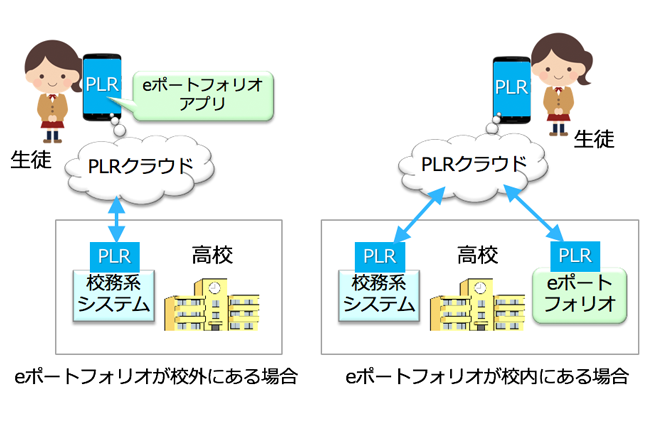① Meet all the requirements for e-portfolio management
The following four points are generally considered as requirements for e-portfolio management.
① Data portability
(XNUMX) Cooperation between the e-portfolio and the school affairs system that records grades and attendance
③ Prevention of unauthorized access to the information system inside the school from outside the school
④ Prevention of unauthorized access to school affairs systems by students
(2017) and (10) are shown in the "Guidelines for Educational Information Security Policy" (October XNUMX) formulated by the Ministry of Education, Culture, Sports, Science and Technology.
Dataability means that the data subject himself / herself obtains personal data (personal information) electronically from an administrator (for example, a business operator such as a school or hospital) and obtains it without being disturbed by the original administrator. It can be freely used, such as by voluntarily disclosing it to others, and for that purpose, it is necessary to link PDS (Personal Data Store) with the e-portfolio.In addition, since teachers take in information on the e-portfolio and create a survey report for each student using the school affairs system, it is essential to link the e-portfolio with the school affairs system (②).The issues at that time are ③ and ④, and how to overcome them has been a big issue so far.
This time, Professor Hashida and Saitama Prefecture will solve this problem at once by using PLR (Personal Life Repository) developed by Professor Hashida as PDS. PLR is a type of distributed PDS, and Assembrogue, which was founded by Professor Hashida, owns the intellectual property rights.Whereas most PDSs share data through centralized management, PLR allows the data to be managed only by the person who is the data subject, so that the PLR cloud can be shared with various others without intervention by others. You can freely share data via.Moreover, since a third party cannot access the data without the explicit consent of the person, the data of all the members will not be leaked together.Furthermore, DRM (Digital Rights Management), that is, data encryption and application function restrictions, not only prevents information leakage due to the mistakes of users (individuals and businesses), but also allows students to make private statements, etc. It is possible that even if you have the data of, the students themselves do not know the contents.
Specifically, when the e-portfolio system is outside the school (Case XNUMX), the school affairs system is connected to the PLR inside the school, and the student's PLR is connected via the PLR cloud.On the other hand, if the e-portfolio system is in the school (Case XNUMX), it is connected to the PLR in the school as in the school affairs system, and it is connected to the student's PLR via the PLR cloud.In either case, if the connection to the outside of the school is limited to the connection from the inside to the outside by the PLR in the school (data flow is bidirectional), the information system in the school will not be accessed from outside the school.In addition, if the data sent from the school affairs system to the PLR cloud is limited to the data that can be provided to the student, such as the student's report card, the student cannot illegally access the school affairs data.
Since various free online storages can be used in the PLR cloud, there is almost no cost even if the number of users becomes huge.Most online storage encrypts the channel, making it even more secure.
Professor Hashida said, "I think that only PLR exists as a PDS that can link with the information system in the school while preventing access to the information system in the school from outside the school." Even if there are hundreds of millions of users, the entire service can be operated with only the maintenance cost of the application, and it is extremely cheap. "

(XNUMX) I want to connect to EdTeck, HR Teck, and "Study Log" concept.
Generalizing e-portfolio into learning systems raises expectations as a foundation for new methods of education and new approaches.If students can access the data of the learning system from outside the school such as at home, the data acquired by PLR from the learning system can be provided to the school affairs system by PLR, so that the data of school affairs and learning can be safely stored. It is also possible to link and integrate.This concept also leads to the "Study Log" concept, in which the Ministry of Education, Culture, Sports, Science and Technology looks ahead to the lifelong learning era and allows each and every citizen to utilize their learning history.In addition, if it becomes possible to collect and analyze big data of learning, it will lead to the promotion of EdTeck (Education × Technology) and HR Teck (“HR (Human Resource) × Technology), and improve the quality of education for each person. It will be possible to improve it more than ever. Of course, if the learners themselves manage their grades and utilize them on their own initiative, private education service providers will also use the data in unprecedented detail. Service is available.
The spread is not limited to the field of education.In the near future, if it becomes possible to manage and utilize medical / health information such as maternal and child health handbooks and health examinations, as well as purchase history, etc., it will be possible to improve the overall quality of life of each person and promote industry and culture. It is expected that it will also lead to.

Graduate School of Information Science and Engineering, The University of Tokyo
Professor, Social ICT Research Center
RIKEN Center for Innovative Intelligence
Distributed Big Data Team Team Leader
